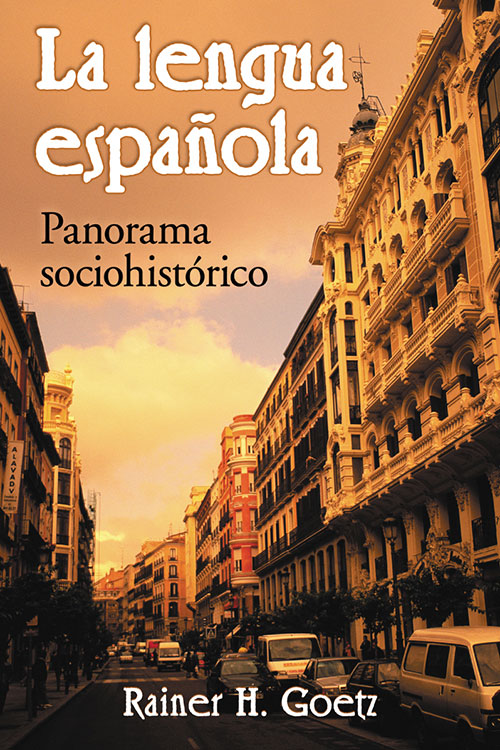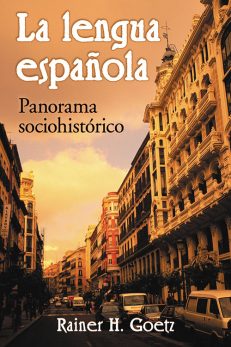La lengua española
Panorama sociohistórico
Original price was: $29.95.$14.99Current price is: $14.99.
In stock
About the Book
The Spanish language has a long and rich history, from its prehistoric roots to its position today as the mother tongue of nearly 400 million inhabitants of 21 countries. How the language originated, how it evolved, and how it is spoken today around the world makes for a fascinating story that greatly enhances the study of written and spoken Spanish.This Spanish–language text covers the history of Spanish from its pre–Roman and Latin roots to its standardized form and its many regional variations. Along the way, discussion covers the spread of Latin on the Iberian Peninsula, the development of romance dialects due to a number of sociolinguistic influences, and the process of creating a standard variety of Spanish. It concludes with a discussion of the origin and the range of dialects that are spoken across the vast geographical area that forms the Spanish–speaking world. Details of pronunciation, spelling, grammar, and vocabulary are explained in their historical context, giving the student of Spanish a deeper understanding of the language as a whole. Perfect for students of Spanish as well as Spanish–speaking readers seeking to expand their general knowledge of the language, this book also includes a glossary of basic linguistic terms discussed in the text.
Instructors considering this book for use in a course may request an examination copy here.
La lengua española tiene una rica y larga historia, desde sus raíces prehistóricas hasta su estado actual como la lengua materna de casi 400 millones de habitantes en 21 países. El cómo se originó, cómo evolucionó, y cómo se habla hoy en día alrededor del mundo contribuye a una historia fascinante que complementa el estudio del español escrito y hablado.
El presente texto, en lengua española, trata la historia del español desde sus raíces prerromanas y latinas hasta su forma estandarizada y sus múltiples variantes regionales. A lo largo de la narrativa se cubre la expansión del latín en la Península Ibérica, el desarrollo de los dialectos romances debido a una serie de influencias de tipo sociolingüístico, y el proceso de crear una variante estándar del español. El libro concluye con una discusión de los orígenes y de la variedad de dialectos que se hablan en la vasta zona geográfica que comprende el mundo hispanohablante. Los pormenores de la pronunciación, la ortografía, la gramática, y el vocabulario se explican dentro de su contexto histórico, y proporcionan al estudiante del español un entendimiento más profundo de la lengua en su totalidad. El libro es perfectamente adecuado para los estudiantes del español tanto como para otros lectores hispanohablantes que desean aumentar sus conocimientos de la lengua, e incluye también un glosario de los términos lingüísticos elementales que se tratan en el texto. Instructors considering this book for use in a course may request an examination copy here.
About the Author(s)
Bibliographic Details
Rainer H. Goetz
Format: softcover (6 x 9)
Pages: 233
Bibliographic Info: maps, glossary, bibliography, index
Copyright Date: 2007
pISBN: 978-0-7864-2989-9
eISBN: 978-0-7864-5135-7
Imprint: McFarland
Table of Contents
Contenido
Preface v
Prefacio vii
Arreglos tipográficos xi
Introducción 1
1. La variabilidad del lenguaje 9
2. La prehistoria del español 25
3. Los romanos y el latín en la Península Ibérica 34
4. El latín de Hispania 45
5. La Hispania posrromana y árabe 63
6. Los dialectos romances septentrionales 80
7. Características del dialecto burgalés 90
8. La consolidación y expansión del castellano 109
9. Del dialecto castellano a la lengua española 119
10. El español estándar 140
11. La dialectología peninsular 154
12. El español en la América Latina (I) 164
13. El español en la América Latina (II) 178
14. El español en el mundo 188
15. Conclusiones 199
Glosario de términos lingüísticos 203
Bibliografía 211
Índice de materia 219
Book Reviews & Awards
“this book is for serious students of the Spanish language”—Reference & Research Book News.





